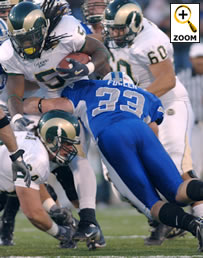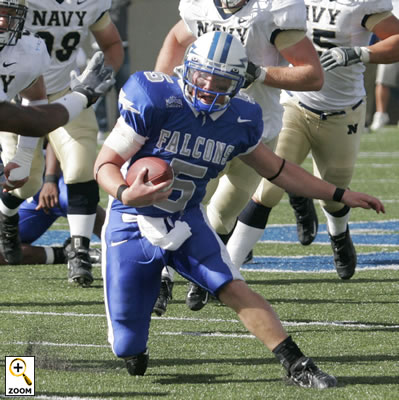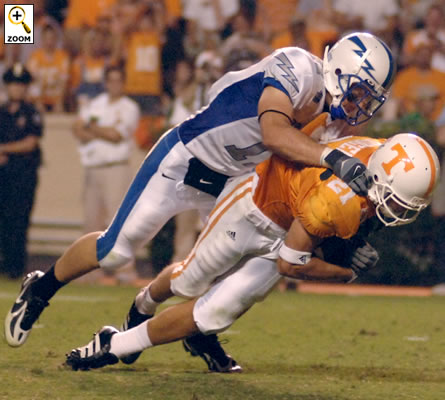| |
| at
Tennessee |
LOST
30-31 |
| at
Wyoming |
WON
31-24 |
| NEW
MEXICO |
WON
24-7 |
| NAVY |
LOST
17-24 |
| COLORADO
STATE |
WON
24-21 |
| at
San Diego State |
LOST
12-19 |
| BRIGHAM
YOUNG |
LOST
14-33 |
| at
Army |
WON
43-7 |
| NOTRE
DAME |
LOST
17-39 |
| UTAH |
LOST
14-17 |
| at
UNLV |
LOST
39-42 |
| at
TCU |
LOST
14-38 |
|
2006
Final Rankings
AP-UR, Coaches-UR, BCS-UR
|
| 2007
Outlook |
| The
longest I-A coaching tenure, that of beleaguered
departee Fisher DeBerry, is over. It gives
way – for the first time in school
history – to an alum. New head coach
Troy Calhoun brings a rather well-rounded
résumé that will allow him
to intently oversee the many areas he is
updating. He keeps or brings back many assistants
who were here under DeBerry, so the continuity
of many key intangibles will already be
established. Calhoun is even keeping the
“flexbone” since most of the
team already knows it, but that scheme gives
way to (and will share the play-calling
with) the current spread looks. Overall,
the spread will dominate the AFA offense.
We see the most immediate need – that
of a QB who can run such complex formations
and make them work – already met since
senior Shuan Carney ran this type of offense
in high school and was very successful at
it. As usual, the OL is undersized and thusly
challenged against well-sized foes. But
the spread allows them to often pass-block
against four or five guys instead of running
all the time from side to side trying to
stop nine guys like in the labor-intensive,
somewhat predictable flexbone. The Falcons
enter the 21st century, and their players
can now be more productive for their efforts…or
as some have put it, Calhoun is putting
the “air” back in Air Force.
That’s all well and good, but it will
be the defense, if anything, that costs
this team any chance at a bowl birth. The
same size troubles along the DL luckily
can be cleaned up by a decent LB corps led
by All-MWC Drew Fowler, but little can compensate
for a secondary that tackles well, but is
often suspect in coverage. This is a team
made up of two-star cadet airmen, a pretty
tough place to find lots of individual talent,
but a great place to find discipline and
teamwork beyond that of most programs. And
it translates – Air Force had 17 winning
seasons out of DeBerry’s 23 here.
The Falcons fly into Annapolis, South Bend,
Provo, and Salt Lake, a daunting road slate
to say the least. But this team has the
looks of one that can finish above .500
if they can take early lumps and turn them
into lessons for later victory. Otherwise,
results from the tough early half of their
schedule could infect the psyche throughout
2007 in Colorado Springs. This may, again,
not be the Airmen’s year, so improving
their defensive showing should be the biggest
priority, one that would best affect the
team’s worth for seasons to come.
Projected
2007 record: 6-6
|
|
 |
| LB
Drew Fowler |
| AIR
FORCE
*POWER RATINGS |
| Offense |
Defense |
| QB
- 3.5 |
DL
- 3 |
| RB
- 3 |
LB
- 3 |
| WR
- 2.5 |
DB
- 2.5 |
| OL
- 3 |
.. |
|
| RETURNING
LEADERS |
| Passing:
Shaun Carney, 149-91-6, 1315 yds., 11 TD
Rushing: Shaun Carney, 159 att.,
596 yds., 6 TD
Receiving: Justin Handley, 13 rec.,
127 yds., 1 TD
Scoring: Shaun Carney, 6 TD, 1 two-pt.
conv., 38 pts.
Punting: Donny Heaton, 47 punts,
41.3 avg.
Kicking: None
Tackles: Mark Carlson, 73 tot., 35
solo
Sacks: Dennis Poland, 4 sacks
Interceptions: Chris Sutton, 2 for
44 yds.
Kickoff returns: Justin Handley,
8 ret., 20.5 avg., 0 TD
Punt returns: Chris Sutton, 11 ret.,
7.0 avg., 0 TD
|
|
|
|
| |
| OFFENSE
- 5 |
----RETURNING
STARTERS---- |
DEFENSE
- 7 |
|
| KEY
LOSSES |
| OFFENSE:
Victor Thompson-WR, Robert Kraay-OT, Stuart
Perlow-C, Tyler Dohollow-OG, Curtis Grantham-OG,
Jacobe Kendrick-FB, Beau Suder-HB, Zach Sasser-K/P |
| DEFENSE:
Gilberto
Perez-DE, Kevin Quinn-DT, Grant Thomas-NG,
Joey Keller-ILB, Chris Sutton-CB, Brad Meissen-FS |
|
|
| 2007
OFFENSE |
| The
triple “flexbone” option that defined
the Falcons for over two decades under DeBerry
isn’t going to be discarded like many believe.
Instead, Tim Horton, who served here as an assistant
but has never been a coordinator, will learn to
juggle the spread, the ‘I’ and the
flexbone as he is mentored by coach Calhoun. Predictability
was slowly killing the Falcon offense in these
modern days of innovation, so Calhoun and Horton
will play-call to their players’ strengths
instead of asking them all to bend to the rigidity
of the archaic wishbone-type running plays (AFA
ran 80% of the time). This won’t be a problem
for their signal caller, Shuan Carney, who ran
a variation of the spread in high school –
his senior prep campaign yielded 3,849 passing
yards and 30 TDs, which nearly eclipses his career
AFA totals of 3,900 yards and 30 TDs. The all-conference
senior is only 5’10, and with the newness
and unpredictability of the spread, don’t
be surprised when Horton has him roll out on pass
plays to get him a better view downfield. Carney
makes good decisions, but he will have to learn
to throw it away more often instead of running
it if/when receivers aren’t open. Backup
Eric Herbert looked decent in spring reps, but
his lack of experience and size means former backup
Jim Ollis could still find himself behind center,
if necessary. Horton has been keen on the quick,
well-sized Ollis being utilized somehow/where
since his last tenure under DeBerry, and the move
is a good one that keeps defenses guessing when
he is in the backfield. Another player looking
to expand his responsibility is 2006’s team
leading rusher, smallish senior Chad Hall. Moved
to become the official ‘Z’ receiver,
All-MWC Hall now plays a Reggie Bush-type of ‘slash’
role, lining up in different capacities to promote
matchup troubles. Hall’s move is due to
the confidence coaches have in Chad Smith, a heady
senior who led the team with his 6.2 ypc average.
But the main reason most running plays have worked
in the recent past is due to fullback Ryan Williams
– he’s that unsung kind of hero, the
one whose blocks always make more room for a Falcon
runner and who always gets positive yards when
given the rock (oops, he did lose a few yards…a
total of two during his 174 carrier carries).
The poignancy of using these weapons en mass (via
the flexbone) should have even more damage with
foes spread out and forced to send extra men into
coverage. The linemen only return two with starting
experience – Blaine Guenther moves back
to center and Nicholas Charles has bulked up to
make his mobility work better. Guenther is their
best lineman, and being able to oversee the blocking
calls will help the new faces in these ever-intricate
schemes. Chris Monson’s move from DE has
gone well so far; with the increased passing,
this former prep TE’s assignment at left
tackle is just as important as Guenther’s
and he has the toughness to overcome his size
deficiency. Seniors Ryan Zeman and Caleb Morris
earned their starts, but they will have to prove
their worth before many runs are sent to their
right side. Lighter linemen mean worthy downfield/lateral
blocking, but how they fare as a unit in the spread
could cause coaches to readjust the line’s
look accordingly. Travis Dekker will find himself
downfield in the pattern more since coaches have
been clear about expanding the tight end’s
capacity. Receiver Mark Root, like Dekker, will
become a field-stretcher since the two of them
are the biggest targets available. Prep state
sprint champ (100m & 200m, Utah) Matt Davis
is too fast not to have a contributing role as
a Z-slot reserve. It is important more receivers
are found, for the multiple-WR sets now seen here
need to have enough threat so DBs/LBs will be
effectively spread and will also bite on (play-action)
fakes. Carney thrived all spring, but the rest
of the offensive players, recruited/procured mostly
for the flexbone, are still adapting, hence the
continued inclusion of the old approach. A confident
QB means this offense should do better than many
that are in first-year regimes and dealing with
revamped strategies, but growing pains and fine
tuning shouldn’t affect where the AFA offense
will find itself by November.
|
 |
| QB
Shaun Carney
|
|
 |
| AIR
FORCE 2007 DEPTH CHART
Returning Starters in bold |
| OFFENSE |
| QB |
Shaun
Carney-Sr (5-10, 190) |
Eric
Herbort-So (5-11, 180) |
| FB |
Ryan
Williams-Sr (5-9, 215) |
Scott
Peeples-Sr (5-10, 220) |
| TB |
Chad
Smith-Sr (5-10, 190) |
Jim
Ollis-Sr (5-11, 190)
Kip McCarthy-Sr (5-10, 190) |
| WR |
Chad
Hall-Sr (5-8, 180) |
Matt
Davis-Jr (5-11, 175) |
| WR |
Mark
Root-Jr (6-2, 195) |
Mike
Moffett-Jr (5-11, 195) |
| TE |
Travis
Dekker-Sr (6-4, 240) |
Keith
Madsen-Jr (6-3, 230) |
| OT |
Chris
Monson-Sr (6-4, 255) |
Dan
Holder-Sr (6-6, 280) |
| OG |
Nicholas
Charles-So (6-4, 280) |
Peter
Lusk-So (6-3, 260) |
| C |
Blaine
Guenther-Sr (6-2, 270) |
Andrew
Pipes-Jr (6-1, 260) |
| OG |
Caleb
Morris-Sr (6-2, 275) |
Tyler
Weeks-Jr (6-1, 270) |
| OT |
Ryan
Zeman-Sr (6-4, 265) |
Chris
Campbell-So (6-5, 250) |
| K |
Ryan
Harrison-Jr (6-1, 175) |
Trey
Eaton-Jr (6-2, 180) |
|
|
| 2007
DEFENSE |
| For
the past few years, this side of the ball has
been the main reason the Falcons haven’t
had a winning record. They allowed fewer points
in ’06 than the two previous years, but
four of the six games in which they allowed 30+
(all six were losses) last year occurred in the
second half of the season, and allowing 42 points
to bottom-feeder UNLV (2-11) was an ominous swansong
for DeBerry. Enter coordinator Tim DeRuyter, a
former AFA player/assistant who returns after
his successful tenure as DC at Nevada and Ohio.
DeRuyter’s 2006 results in Reno saw only
Arizona State, Hawai’i and Boise State break
the 30-point barrier, and his guys holding Miami
to 21 points in their bowl loss shows his ability
to motivate. Six legitimate starters out of the
front seven should mean improvements to Air Force’s
No.68 rushing defense. The two starting ends in
the new-look 3-4 are well-sized and hungry –
Ryan Kemp is a 255-lb. top-notch high jumper,
while heady ex-LB Jake Paulson regularly takes
up two blockers, as does former starter Josh Clayton
(lost the start when he broke his wrist). The
tackle is tough, but Jared Marvin is simply too
small (at 230lbs.) to force the amount of double-teams
a NT must command. Lifetime AFA-er Keith Williams
offers more size and will see lots of reps if/when
Marvin comes up short as a clogger. Inside linebacker
Drew Fowler will clean up the middle with his
all-conference status; the senior is the best
defenseman on the team, nearly doubling the tackles
of OLB John Rabold. Fellow outsider Julian Madrid
is another senior who excels in coverage, but
he tentatively lost his starting nod to Hunter
Altman since he was held out this spring recovering
from a knee injury. Aaron Shanor played his way
into the start at the other inside linebacker
spot through his fabulous spring showing, but
he will have to stay on top of his game to hold
off experienced senior Austin Randle. The corps
(and the entire front seven, sans the NT) has
the athleticism and size to keep up with foes
at any level, so adding an extra guy can only
help their stat line(s) as they swarm. Still,
more sacks and TFLs are needed for this D to take
it to any ‘next levels’. The secondary
features Bobby Giannini, their free safety who
is great in run support but marginal (at best)
when the rock is thrown. Soph Chris Thomas has
the same moniker, and with other underclassmen
behind both, something will have to give for the
Falcons not to eventually pay huge costs due to
these factors. Senior corner Garrett Rybak did
well as the No.2 corner last year, but handling
the top assignment(s) weekly now could prove too
much. Senior Carson Bird lulled last year after
a standout sophomore campaign, but speedy Nathan
Smith will push Bird as he realizes his climb
up the learning curve. This secondary broke up
a mere 21 of their foes’ 300+ passes, had
a modest nine INTs, and allowed two-thirds of
their attempts to be completed on the way to 20
aerial scores. Furthermore, the defense allowed
opponents to convert 56% of their third-down tries
and gave up 4.1 ypc on runs. The new staff has
to get the pass rush up to par before the passing
defense can make some big plays and have the desired
impact. With their largest lineman listed at 260,
speed and teamwork have to compensate against
those bigger opponents…and, after three
years of that “maybe” happening (but
which leads to eventual failure), proof will only
be found in the pudding.
|
 |
| DB
Bobby Giannini
|
|
 |
| AIR
FORCE 2007 DEPTH CHART
Returning Starters in bold |
| DEFENSE |
| DE |
Jake
Paulson-Jr (6-5, 260) |
Myles
Morales-So (6-3, 240) |
| NG |
Jared
Marvin-Jr (6-2, 230) |
Keith
Williams-Jr (6-6, 255)
Ben Garland-So (6-4, 240) |
| DE |
Ryan
Kemp-Jr (6-5, 235) |
Josh
Clayton-Sr (6-4, 260) |
| OLB |
John
Rabold-Sr (6-4, 220) |
Trent
Burney-Jr (6-2, 185) |
| ILB |
Drew
Fowler-Sr (6-2, 235) |
Austin
Randle-Sr (6-0, 230) |
| ILB |
Aaron
Shanor-Sr (6-1, 225) |
Jon
Falgout-So (6-0, 215) |
| OLB |
Julian
Madrid-Sr (6-0, 205) |
Hunter
Altman-Jr (5-11, 195) |
| CB |
Carson
Bird-Sr (5-11, 190) |
Kevin
Rivers-Jr (6-0, 190) |
| CB |
Garrett
Rybak-Sr (5-11, 175) |
Nathan
Smith-Jr (5-10, 180) |
| SS |
Chris
Thomas-So (5-11, 198) |
Blake
Brooks-So (6-0, 180) |
| FS |
Bobby
Giannini-Jr (6-2, 210) |
Aaron
Kirchoff-So (6-1, 200) |
| P |
Ryan
Harrison-Jr (6-1, 175) |
Brandon
Geyer-So (6-4, 190) |
|
|
|
|
| 2007
SPECIAL TEAMS |
| Junior
Ryan Harrison was accurate and consistent throughout
spring ball, enough so to secure both kicking duties.
Coverage on kick returns has been excellent, but the
same cannot be said of punt coverage. The new attitude
on defense, along with so many on the JV squad wanting
to prove their worth, should help the new staff find
better results these ways. Almost anyone who had a kick
and/or punt return of some kind has moved on. Of those
left, corner Chris Thomas did the best job; he will
find a new bunch of no-names ready to compete for the
nod and finally get some meaningful reps themselves.
One steady performer at each return job has to be the
goal, though, or special teams won’t be much help.
This team has had 99 kick blocks since 1990, a tradition
that needs to continue for this team to get those well-earned
and needed breaks.
|
| |
| |
|
|
|